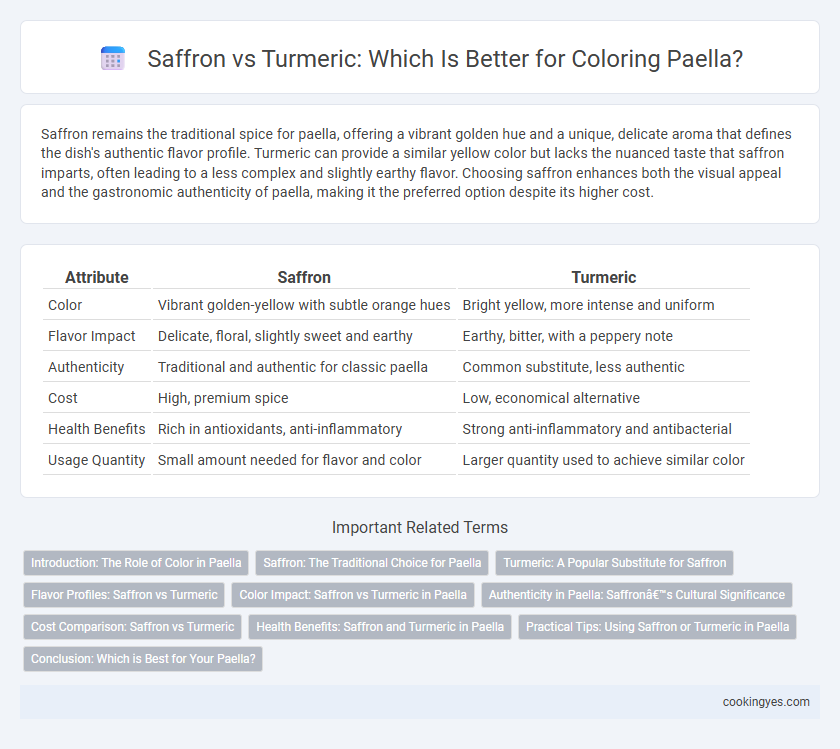Saffron remains the traditional spice for paella, offering a vibrant golden hue and a unique, delicate aroma that defines the dish's authentic flavor profile. Turmeric can provide a similar yellow color but lacks the nuanced taste that saffron imparts, often leading to a less complex and slightly earthy flavor. Choosing saffron enhances both the visual appeal and the gastronomic authenticity of paella, making it the preferred option despite its higher cost.
Table of Comparison
| Attribute | Saffron | Turmeric |
|---|---|---|
| Color | Vibrant golden-yellow with subtle orange hues | Bright yellow, more intense and uniform |
| Flavor Impact | Delicate, floral, slightly sweet and earthy | Earthy, bitter, with a peppery note |
| Authenticity | Traditional and authentic for classic paella | Common substitute, less authentic |
| Cost | High, premium spice | Low, economical alternative |
| Health Benefits | Rich in antioxidants, anti-inflammatory | Strong anti-inflammatory and antibacterial |
| Usage Quantity | Small amount needed for flavor and color | Larger quantity used to achieve similar color |
Introduction: The Role of Color in Paella
Saffron is the traditional and most prized spice used for coloring paella, imparting a vibrant golden-yellow hue and a distinct aromatic flavor that defines authentic Valencian cuisine. Turmeric serves as a cost-effective alternative, providing a bright yellow color but lacking the nuanced fragrance and subtle taste that saffron offers. The choice between saffron and turmeric significantly influences the visual appeal and sensory experience of paella, with saffron regarded as essential for culinary authenticity.
Saffron: The Traditional Choice for Paella
Saffron remains the traditional and preferred choice for paella coloring due to its unique flavor profile and vibrant golden-yellow hue that enhances both aroma and taste. Unlike turmeric, which only adds color without contributing the subtle earthy and floral notes, saffron imparts an authentic and rich sensory experience essential to classic paella recipes. Its natural compounds, crocin and safranal, are key to achieving the signature appearance and complex flavor complexity that define traditional Spanish paella.
Turmeric: A Popular Substitute for Saffron
Turmeric is a popular substitute for saffron in paella due to its vibrant yellow color and affordability, making it accessible for many home cooks. While turmeric imparts a bright hue, it lacks the distinctive floral and earthy aroma of saffron, which is derived from Crocus sativus stigmas. Using turmeric alters the traditional flavor profile but provides a budget-friendly option to achieve the characteristic golden color of classic paella dishes.
Flavor Profiles: Saffron vs Turmeric
Saffron imparts a delicate, floral, and slightly earthy flavor to paella, enhancing the dish's complexity with its subtle bitterness and distinctive aroma. Turmeric offers a more robust, earthy, and slightly peppery taste, which can overpower the traditional flavor balance of paella. Choosing saffron ensures an authentic flavor profile, while turmeric provides a budget-friendly alternative with a distinctly different taste.
Color Impact: Saffron vs Turmeric in Paella
Saffron imparts a rich golden-yellow hue to paella with subtle orange undertones, creating the traditional vibrant appearance prized in authentic recipes. Turmeric provides a brighter, more intense yellow color that can overpower the dish's delicate flavors and alter its traditional profile. The choice between saffron and turmeric significantly affects the visual appeal and authenticity of paella's color.
Authenticity in Paella: Saffron’s Cultural Significance
Saffron is the traditional and authentic spice used in paella, prized for its unique aroma and rich golden color that defines the dish's cultural heritage. Turmeric, while sometimes used as a cheaper substitute, lacks the depth of flavor and historical significance embedded in Spanish cuisine. Using saffron maintains the true essence of paella, honoring its Valencian roots and the centuries-old culinary traditions.
Cost Comparison: Saffron vs Turmeric
Saffron, the traditional spice for authentic paella, commands a high price due to its labor-intensive harvesting and limited supply, often costing hundreds of dollars per ounce. Turmeric provides a cost-effective alternative, offering vibrant yellow coloring at a fraction of saffron's price, typically under $10 per pound. While saffron imparts a subtle floral and earthy flavor essential for genuine paella, turmeric solely contributes color without replicating saffron's complex taste profile.
Health Benefits: Saffron and Turmeric in Paella
Saffron and turmeric both add vibrant color and health benefits to paella, with saffron offering potent antioxidant properties that support heart health and reduce inflammation. Turmeric contains curcumin, a powerful anti-inflammatory compound linked to improved brain function and joint health. Using saffron enhances the traditional flavor and provides mild mood-boosting effects, while turmeric enriches paella with immune-boosting and digestive benefits.
Practical Tips: Using Saffron or Turmeric in Paella
Saffron delivers the authentic golden hue and subtle floral aroma essential for traditional paella, while turmeric provides a budget-friendly alternative with a bright yellow color but lacks the complex flavor profile. When using saffron, steep the threads in warm broth before adding to maximize color and taste extraction, whereas turmeric should be added sparingly to avoid overpowering bitterness. To balance cost and authenticity, blend a small amount of saffron with turmeric, ensuring vibrant color without compromising the signature paella flavor.
Conclusion: Which is Best for Your Paella?
Saffron remains the superior choice for authentic paella due to its unique aroma, subtle flavor, and vibrant golden hue that enhances the dish's traditional profile. Turmeric can mimic the color effectively but lacks the complex taste and aroma that define classic Valencian paella. For a true paella experience, investing in high-quality saffron ensures both visual appeal and depth of flavor, making it the best option for your recipe.
Saffron vs Turmeric for Paella coloring Infographic

 cookingyes.com
cookingyes.com